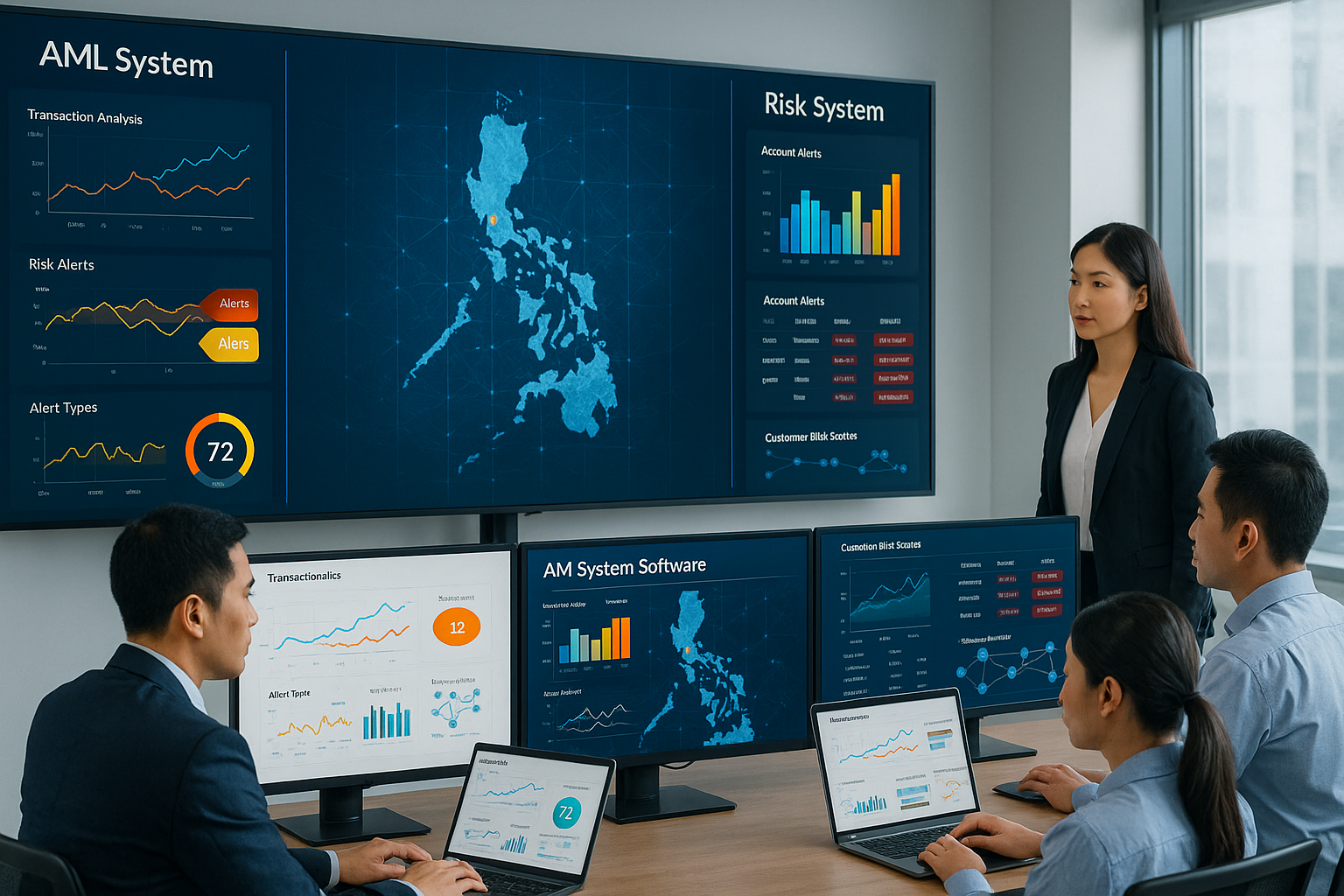Why Transaction Monitoring Is the Heart of Modern AML Compliance
.svg)
Transaction monitoring in money laundering prevention has become a mission-critical function for financial institutions navigating today’s complex risk landscape.
As laundering tactics grow more sophisticated and cross-border transactions surge, traditional detection methods are no longer enough. Financial institutions must deploy intelligent, real-time transaction monitoring systems that not only identify suspicious patterns but also adapt to evolving typologies.
Beyond flagging anomalies, effective transaction monitoring in money laundering helps institutions meet global compliance standards, reduce operational inefficiencies like false positives, and strengthen their investigative capabilities.
In this article, we unpack how transaction monitoring works, why it’s essential for anti-money laundering (AML) compliance, and what features modern institutions need to detect and disrupt illicit financial flows with confidence.
The Essentials of Transaction Monitoring
Transaction monitoring is pivotal in preventing financial crimes. It's the process where financial institutions continuously track transactions to identify suspicious activities.
The goal is to spot transactions that don't fit a customer's typical patterns. This involves monitoring various facets such as transfers, deposits, and withdrawals.
Several key components define an effective transaction monitoring system:
- Customer Profiling: Establishing normal behaviour patterns.
- Rule-Based Systems: Setting predefined thresholds and criteria.
- Behavioural Analysis: Identifying deviations from expected activities.
- Real-Time Monitoring: Ensuring timely detection of anomalies.
- Machine Learning Algorithms: Enhancing pattern recognition accuracy.
Each of these elements contributes to a robust defence against money laundering. Together, they ensure that financial institutions can swiftly detect and act upon suspicious activities.
Understanding these essentials empowers AML professionals to optimize their transaction monitoring processes. As financial crime becomes more sophisticated, adapting these foundational elements is crucial for staying ahead.

What is Transaction Monitoring in AML?
Transaction monitoring in AML is a systematic approach used by financial institutions. It involves scrutinising customer transactions to spot potential money laundering activities.
This process is not passive. Instead, it actively involves tracking all financial transactions. From small transfers to large withdrawals, nothing goes unnoticed.
The system flags unusual transactions that warrant further investigation. For instance, sudden large sums deposited without a clear origin might raise red flags.
The key is in the details. By closely analysing transactions, financial institutions can detect patterns that suggest financial crimes. This proactive approach is essential to AML efforts, ensuring institutions remain compliant and secure.
{{cta-whitepaper}}
The Importance of Transaction Monitoring for Financial Institutions
Transaction monitoring is more than a regulatory requirement. It is a critical component for safeguarding financial institutions against illegal activities.
Effective monitoring helps identify and mitigate risks early. It offers a layer of protection, preventing money laundering before it can harm the institution or its clients.
For financial institutions, failure to monitor transactions can lead to severe consequences. Penalties, reputational damage, and operational disruptions are just a few potential outcomes.
Moreover, maintaining customer trust is paramount. A robust transaction monitoring system reassures clients that their funds are secured within a compliant institution.
Thus, transaction monitoring serves as the backbone of financial institutions' AML programs, ensuring both compliance and security. It's a practice that has become indispensable in the fight against financial crime.
The Transaction Monitoring Process Explained
The transaction monitoring process is both intricate and comprehensive. It commences with collecting and analysing transaction data to detect irregular patterns that might signify money laundering.
The primary objective is to identify transactions deviating from a customer's usual activities. This involves scrutinising deposits, withdrawals, and transfers in real time.
A critical aspect of this process is the integration of various technological tools. These include rule-based systems, machine learning algorithms, and big data analytics. Together, they enhance the precision of detecting suspicious transactions.
Financial institutions follow a structured approach:
- Data Collection: Gather transaction data from multiple sources.
- Pattern Analysis: Compare data against known behaviours.
- Alert Generation: Create alerts for activities requiring attention.
- Investigation: Conduct a detailed review of flagged transactions.
- Decision Making: Decide on the appropriate action.
Effective transaction monitoring also hinges on collaboration among different departments within an institution. This ensures a coordinated response to potential threats.
Additionally, the process must adapt as financial landscapes evolve. Institutions regularly update their systems to address emerging threats and comply with changing regulations.
Monitoring isn't complete without regulatory reporting. Filing Suspicious Activity Reports (SARs) is mandatory when potential money laundering is detected, serving as a communication bridge between financial institutions and authorities.
Ultimately, transaction monitoring is not a static, one-size-fits-all operation. It requires continuous enhancement to protect institutions from the dynamic threats posed by financial crimes.
Identifying Suspicious Activities: Transfers, Deposits, and Withdrawals
Identifying suspicious activities is a crucial goal of transaction monitoring. Each transaction type—transfers, deposits, and withdrawals—presents its own red flags.
Transfers moving between accounts without a logical reason can arouse suspicion. These may involve frequent movement of funds between multiple accounts or beneficiaries.
Large, unexplained deposits are another warning sign. Such deposits, especially when inconsistent with a customer's regular income patterns, require scrutiny.
Withdrawals that are disproportionate to an account's typical activity can also trigger alarms. Particularly large cash withdrawals or those made on irregular schedules might indicate money laundering attempts.
The role of technology is invaluable in this identification process. It helps sift through vast amounts of data to pick out anomalies that human operators might miss.
Moreover, behavioural analysis augments traditional rule-based methods. By evaluating deviations from expected norms it can reveal hidden threats.
Precision in identifying suspicious activities is pivotal. It reduces false positives and enhances the ability of financial crime investigators to intervene effectively.
The Role of Customer Due Diligence in Transaction Monitoring
Customer due diligence (CDD) is foundational to effective transaction monitoring. It starts with thoroughly understanding a customer's financial habits and risk profile.
CDD involves gathering and verifying identity information, financial history, and expected account activity. This information sets the baseline for monitoring.
By knowing what to expect from a customer's financial behaviour, institutions can better identify anomalies. It's the initial line of defence against financial crime.
Enhanced due diligence is necessary for high-risk customers. This involves more rigorous checks to ensure compliance with AML regulations and to prevent money laundering.
CDD is not a one-off process. It requires periodic updates to reflect any changes in a customer's circumstances or the broader risk environment. This ongoing vigilance is essential to staying ahead of new money laundering tactics.
Technological Advancements in AML Transaction Monitoring
Technological advancements have revolutionised how financial institutions monitor transactions for money laundering. Emerging tools like machine learning (ML) and artificial intelligence (AI) have drastically improved the efficiency of AML systems.
These technologies enable real-time monitoring, ensuring faster detection of suspicious activities. The use of big data analytics allows institutions to handle larger volumes of transactions with greater precision.
Key technological advancements include:
- Rule-Based Systems: Rely on predefined criteria to flag potential issues.
- Machine Learning Models: Adapt based on new data, refining accuracy over time.
- Behavioural Analytics: Focus on identifying deviations from normal customer activity.
- Automated Workflows: Streamline the alert investigation process for quicker resolution.
Beyond this, advanced analytics aid in better data visualisation, allowing investigators to detect patterns and connections more effectively. This enhances their capability to map out complex money laundering networks.
APIs (Application Programming Interfaces) have become instrumental in integrating AML systems across various platforms. This integration ensures seamless data flow and heightened functionality.
Moreover, cloud computing offers scalability, ensuring that monitoring systems grow alongside transaction volumes. This ensures institutions can continually meet regulatory and security demands.
One major impact of these advancements is the significant reduction in false positives. Streamlined, accurate systems free up resources, allowing for more focused investigations.
Overall, technology has not only enhanced transaction monitoring but also improved the broader landscape of financial crime prevention. Financial institutions are now better equipped to handle the ever-evolving techniques of money launderers.
Regulatory Compliance and Reporting
Regulatory compliance is paramount in the fight against money laundering. Financial institutions must adhere to stringent guidelines, ensuring they monitor transactions effectively.
Compliance requires a robust AML framework, one that meets both national and international standards. Regulatory bodies like the Financial Action Task Force (FATF) set these benchmarks.
A cornerstone of compliance is the accurate and timely filing of Suspicious Activity Reports (SARs). These reports alert authorities to potential money laundering or fraud activities.
Institutions must balance regulation with operational efficiency. This balance can be achieved by integrating regulatory technology (RegTech) solutions into existing systems.
Key compliance measures include:
- Regularly updating transaction monitoring systems for alignment with new regulations.
- Ensuring customer due diligence and maintaining thorough records.
- Establishing a clear procedure for filing SARs promptly and accurately.
- Conducting regular audits to verify system effectiveness and compliance adherence.
Moreover, effective reporting ensures transparency. It helps in creating a trustworthy financial ecosystem. Clear communication with regulatory bodies fosters a cooperative environment for combating money laundering.
Ultimately, maintaining compliance isn't just a legal obligation. It's a critical part of safeguarding the financial system, allowing institutions to function securely and efficiently.
Suspicious Activity Reports (SARs) and Their Significance
Suspicious Activity Reports (SARs) play a crucial role in detecting financial crime. They are formal notifications to authorities about potential laundering activities.
SARs must be filed when transactions seem inconsistent with a customer's profile. This inconsistency could signify illegal activities or attempts at laundering funds.
The effectiveness of SARs relies on the accuracy and relevance of the data they contain. Institutions must ensure that reports include detailed, clear information about suspicious transactions.
Timeliness in filing SARs is essential. Delays could hinder investigations and allow illicit activities to continue unchecked.
Real-Time Monitoring and High-Risk Scenarios
Real-time monitoring is a powerful tool in preventing financial crime. It allows financial institutions to detect suspicious activities immediately as they occur.
Speed is crucial, especially when dealing with high-risk scenarios. Quick detection enables swift action, minimising the impact of potential criminal activities.
High-risk customers or transactions often require enhanced scrutiny. This is particularly true for clients in regions known for money laundering or those involved in large, frequent transactions.
Real-time monitoring involves using advanced technologies to process and analyse transactions instantaneously. This ensures any deviation from normal activity is quickly identified.
Moreover, continuous monitoring aids in managing high-risk situations effectively. It provides a dynamic approach to AML, adapting to new threats as they emerge.
Challenges and Best Practices in Transaction Monitoring
Transaction monitoring presents several challenges that financial institutions must navigate. The sheer volume of transactions demands sophisticated systems that can process and analyse data efficiently. These systems must also adapt quickly to new money laundering tactics.
A major challenge is the high rate of false positives. These are alerts triggered by legitimate activities wrongly flagged as suspicious. False positives can overwhelm compliance teams and divert resources from genuine threats.
Maintaining data integrity is crucial. Poor quality data can lead to inaccurate monitoring results, impeding an institution's ability to detect illicit activities. Therefore, regular data audits and updates are essential.
Incorporating advanced technologies like machine learning and AI can help. These tools enhance transaction monitoring systems, providing more accurate alerts and reducing false positives. Human oversight remains vital, ensuring that systems' outputs align with real-world contexts.
Cross-departmental collaboration within institutions can also improve monitoring. Sharing insights and expertise helps refine detection scenarios and provides a comprehensive view of potential risks.
Best practices include:
- Regularly updating detection algorithms to reflect current threats.
- Training staff on emerging money laundering methods.
- Utilising consortium data to gain a broader perspective on suspicious patterns.
- Balancing technological reliance with human intervention.
Ultimately, effective transaction monitoring requires a holistic approach. By combining technology and human expertise, institutions can create a robust defence against financial crimes.
Balancing Efficiency and Accuracy: The Issue of False Positives
False positives in transaction monitoring are a persistent challenge. They arise when legitimate activities trigger alerts, leading to unnecessary investigations. This inefficiency strains resources and can delay the detection of genuine threats.
One method to address this issue is refining detection algorithms. By adjusting criteria to better match typical customer behaviour, the number of false positives can be reduced.
Additionally, integrating customer context into alert systems improves accuracy. Understanding a client's transaction patterns and background helps differentiate between normal and suspicious activities.
Collaboration between technology and human insights is key. While technology processes vast amounts of data, human oversight provides the context needed to interpret results meaningfully.
In conclusion, reducing false positives requires a balanced approach. By fine-tuning systems and incorporating a deeper understanding of customer behaviour, institutions can enhance both efficiency and accuracy in transaction monitoring.
{{cta('26ec267c-67ce-42a1-bd16-db572d39b89d','justifycenter')}}
Implementing a Risk-Based Approach to Transaction Monitoring
A risk-based approach is central to effective transaction monitoring. It allocates resources based on the level of risk associated with different activities, customers, and geographic regions. This method ensures that high-risk transactions receive the attention they deserve.
Implementing this approach starts with identifying risk factors. Financial institutions must understand their customer base, business activities, and the regions they operate in. This understanding helps tailor monitoring efforts to the highest-risk areas.
Next, institutions should develop a comprehensive risk assessment framework. This framework guides which transactions to focus on, allowing more resources to be directed where they are most needed.
Regular updates and reviews of risk assessments are also crucial. As money laundering methods evolve, so too must the strategies used to combat them. By staying adaptable, institutions ensure ongoing effectiveness in detecting potential threats.
Overall, a risk-based approach optimises transaction monitoring. It prioritises efforts, ensuring that resources are used efficiently to protect against financial crimes.
The Future of Transaction Monitoring in AML
As financial crimes grow more sophisticated, the future of transaction monitoring in Anti-Money Laundering (AML) remains a dynamic landscape. Advancements in technology and regulation are shaping how financial institutions approach these challenges.
Emerging technologies, such as blockchain and AI, offer promising tools. They enable more precise monitoring and can improve both detection and prevention capabilities.
RegTech solutions are gaining traction. These technologies streamline compliance processes, making them more efficient and less resource-intensive.
Yet, with these advancements come ethical considerations. Ensuring that transaction monitoring remains transparent and fair is crucial to maintaining public trust.
Looking ahead, several trends are expected to influence AML efforts:
- Increasing integration of AI and machine learning.
- Enhanced collaboration between public and private sectors.
- Greater emphasis on data protection and privacy.
These trends signal a shift towards more comprehensive and technologically-driven strategies. Institutions will need to adapt quickly to remain effective against new threats.
In this evolving landscape, continuous education and training for financial crime investigators will be vital. This will ensure they remain at the forefront of transaction monitoring innovations.
Global Trends and the Evolution of Anti-Money Laundering Transaction Monitoring
Globally, AML transaction monitoring is undergoing significant evolution. The international nature of financial crime demands coordinated efforts across borders.
Regulatory bodies, such as the Financial Action Task Force (FATF), continue to update AML standards. These changes encourage global consistency in combating money laundering.
Cross-border collaboration is becoming more common. Financial institutions and governments are sharing data and strategies to tackle money laundering more effectively.
Additionally, the rise of digital currencies poses new challenges and opportunities. These currencies require new monitoring techniques to track and prevent illicit activities.
There's also an increasing focus on privacy and data protection. Balancing these concerns with effective monitoring is a key global challenge.
In summary, AML transaction monitoring is on a path of continuous evolution. Adapting to global trends will be essential for financial institutions to stay ahead of criminal tactics.
Conclusion: FinCense: The Future of AI-Driven AML Compliance
In today's complex regulatory landscape, financial institutions face the daunting challenge of ensuring robust Anti-Money Laundering (AML) compliance. Tookitaki's FinCense rises to this challenge, providing a revolutionary tool for transaction monitoring.
With its efficient, accurate, and scalable AML solutions, FinCense is specifically designed for banks and fintechs. It guarantees 100% risk coverage for all AML compliance scenarios, allowing institutions to stay ahead of financial crimes.
FinCense harnesses advanced machine learning capabilities to significantly reduce compliance operation costs by up to 50%. This focus on material risks enhances the speed and quality of compliance reporting.
Moreover, with over 90% accuracy in detecting suspicious activities, FinCense stands out as an AI-driven solution. By monitoring billions of transactions in real-time, it effectively mitigates fraud and money laundering risks.
FinCense is not just a transaction monitoring system; it's a comprehensive AFC Ecosystem that empowers institutions to navigate the complexities of AML compliance effortlessly.
Experience the most intelligent AML and fraud prevention platform
Experience the most intelligent AML and fraud prevention platform
Experience the most intelligent AML and fraud prevention platform
Top AML Scenarios in ASEAN

The Role of AML Software in Compliance

The Role of AML Software in Compliance










